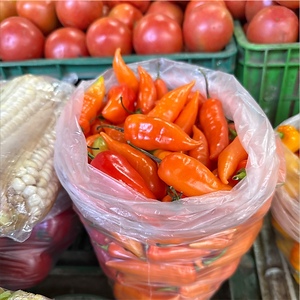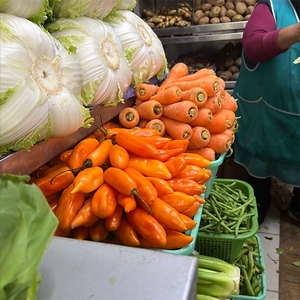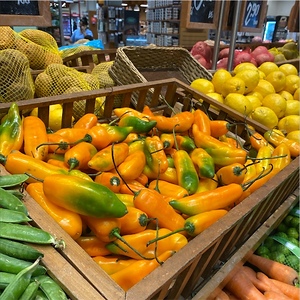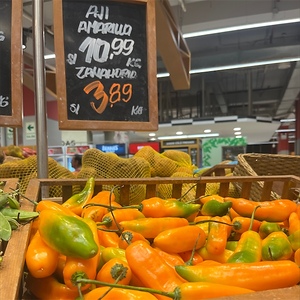

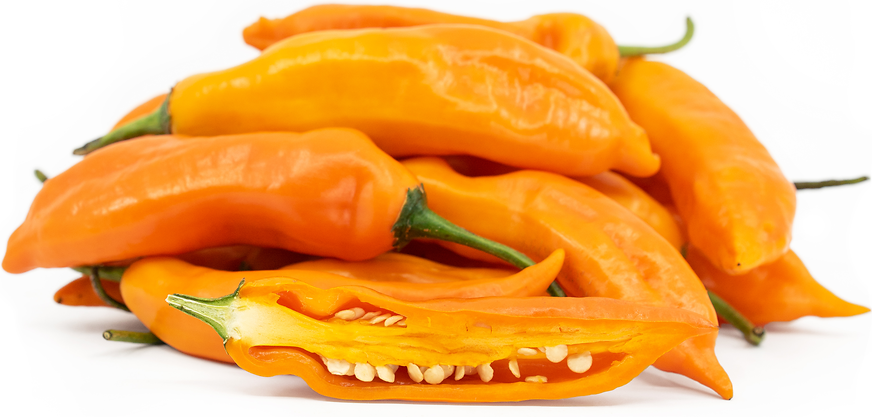
Aji Amarillo Chile Pepper
Estimated Inventory, 10 lbs : 0
Description/Taste
Ají Amarillo varies in size and shape, depending on growing conditions, and generally averages 12 to 15 centimeters in length and 2 to 3.5 centimeters in diameter. The peppers exhibit a slightly curved or straight shape and are typically elongated with a conical, tapered nature. The pods have semi-thick, glossy, and smooth skin, and faint shallow indentations ripple across the surface. Ají Amarillo transitions in color from green, yellow, yellow-orange, to bright orange when ripe. Once dried, they develop a dark orange and brown hue. Underneath the skin, the flesh matches the exterior shades and is thick, crisp, and aqueous. The pods also encase a central hollow cavity filled with porous, spongy membranes and tiny, round, flat, cream-colored seeds. Ají Amarillo releases an aromatic, fruity, vegetal, and rasin-like scent. The peppers are edible raw or cooked and have an initially bright and fruity taste followed by a rush of moderate to hot spice levels. The heat in the pepper is bold and lingering, considered hotter than a jalapeno but milder than a habanero.
Seasons/Availability
Ají Amarillo is available year-round in select regions worldwide. In Peru, the peppers are harvested fresh from May through August, and dried versions are available year-round.
Current Facts
Ají Amarillo, botanically classified as Capsicum baccatum, is a South American variety belonging to the Solanaceae or nightshade family. The ancient species has been a prevalent variety throughout South America as a culinary and medicinal pepper and has remained a staple cooking ingredient into the modern day. The name Ají Amarillo translates from Quechua, an indigenous language of South America, to mean “yellow pepper.” The variety received its yellow moniker from one of the colors the pods transition through during the ripening process. When the peppers are cooked, the skin also turns a golden yellow hue, and many experts believe that this cooked color contributed to the pepper’s name. Ají Amarillo has spread worldwide and has acquired several names, including Ají Escabeche, Ají Peruano, Ají Amarillo Peruano, Challuaruro, Ayuyo, Cacho de Cabra, Uchu, and Chinchiuchú. The variety ranges from 30,000 to 50,000 SHU on the Scoville scale and is regarded as a moderately hot pepper. Ají Amarillo is famously used in Peruvian cuisine and is one of the most consumed peppers in the country, cultivated for domestic use and international export. Ají Amarillo is a versatile pepper, used in culinary preparations fresh and dried, and is favored for its fruity flavor, aroma, and heat.
Nutritional Value
Ají Amarillo is a source of vitamin C to strengthen the immune system, fiber to regulate the digestive tract, potassium to balance fluid levels within the body, and magnesium to control nerve functions. The variety also provides calcium to build strong bones and teeth, vitamin A to maintain healthy organs, flavonoids and phenolic compounds with anti-inflammatory properties, and other nutrients, including iron and vitamin B6. In natural medicines prepared in Peru, Ají Amarillo is rubbed on gums to lessen toothaches and is sometimes used to reduce headaches and altitude sickness.
Applications
Ají Amarillo has a fruity, subtly vegetal taste suited for raw or cooked preparations. The variety is popularly used fresh or dried and incorporated into savory preparations. When raw, Ají Amarillo can be chopped and added to salsas, sliced and tossed into salads, or blended into hot sauces and pastes. The peppers can also be used as flavoring in sauces to drizzle over potatoes, especially in mixtures with huacatay, or they can be stirred into spreads with tamarillos. Ají Amarillo is famously used in Peru to flavor ceviche, the country’s national dish. The peppers add mild heat and fruity flavors to the liquid in the dish, nicknamed “tiger’s milk” in Peru. Tiger’s milk is often drunk from the bowl after ceviche is finished or saved for cocktails, and the peppers add a refreshing zing. In addition to fresh preparations, Ají Amarillo is utilized in cooked preparations, mainly adding flavor rather than heat to dishes. The variety is simmered into soups and stews, cooked into stir-fries such as lomo saltado, a Peruvian-Chinese fusion dish, or stuffed into tamales and empanadas. The Incas once used Ají Amarillo as a source of flavoring, and these peppers have remained one of the most popular varieties used in everyday Peruvian cooking. The peppers are infused in traditional Peruvian dishes, including aji de gallina, tacu tacu, and tiradito. They are also one of three ingredients, along with red onion and garlic, that are included in the Peruvian “holy trinity” of cooking. This trinity is used as a base for many dishes, such as causa a la limeña, which is a layered mashed potato dish with chicken, avocado, and vegetables or mixed into the spicy cheese sauce in papa a la huancaina. Beyond fresh preparations, Ají Amarillo is dried to use the peppers year-round. Dried Ají Amarillo is known as Ají Mirasol and is rehydrated or ground into a powder and used as a spice. Ají Amarillo can also be canned or pickled for extended use. Ají Amarillo pairs well with meats such as poultry, beef, and pork, seafood including scallops, fish, prawns, and shrimp, legumes, potatoes, corn, tomatoes, herbs including huacatay, parsley, and cilantro, and rice. The peppers will keep for 1 to 2 weeks when stored whole and unwashed in the refrigerator. They can also be dried and stored in a sealed container at room temperature for over one year.
Ethnic/Cultural Info
Peppers were revered by the Incas and were believed to have been intertwined into one of the Inca’s creation myths. Legend has it that four brothers were planted on Earth with their wives. One of the brothers, known as Ayar Uchu, roughly meaning “brother chile,” symbolized chile plants. The four brothers were sent on a quest to settle the lands, and along the way, several incidents happened, leading only one brother with the four wives to settle Cusco, later becoming the capital of the Inca Empire. Ayar Uchu embodied the power of chile peppers and was used to convey the teachings of early ancestors. This also led peppers to become a symbol of spiritual power, and many sources mention that the Incas may have used the plants in religious ceremonies as an offering and act of worship. Chile peppers, known as ají, in South America, were also used by the Incas as a form of payment, connecting the chiles as an essential trade commodity. One of the more unusual uses was as a deadly form of punishment. Criminals in the Inca Empire were sometimes hung upside down, and dried chile peppers were burned over the fire beneath them to release irritating vapors. These vapors would travel into the criminal’s nose and mouth, causing discomfort, the inability to breathe, and occasionally death.
Geography/History
Ají Amarillo is native to South America and has been growing wild since ancient times. Much of the pepper’s origins are unknown, but it is thought that the variety first arose from a region near the Lake Titicaca basin and the border of modern-day Peru and Bolivia. Over time, seeds from the peppers were naturally spread throughout South America with animal and human intervention and also through natural elements such as moving water and wind. The oldest archeological findings were discovered in the Guitarrero Cave in the Yungay Province and date back to around 8,000 BCE. Other findings were also found in the Chicama Valley in the La Libertad region in northern Peru, dating to around 2,500 BCE. Multiple varieties of ají, in general, were widely featured in carvings, pottery, and drawings throughout indigenous civilizations in coastal South America. Extensive written records were later noted when the Spanish arrived. Several Spanish chroniclers in the 15th and 16th centuries documented ají among Indigenous populations, and the peppers were highlighted in cultural, religious, medicinal, and culinary uses. Throughout history, Ají Amarillo has remained a prevalent pepper in South America and has spread as a specialty variety worldwide. The peppers are grown in varying climates and are prevalent in Chile, Ecuador, Colombia, Bolivia, and Peru. Outside of South America, the variety is also grown in India, Japan, Costa Rica, the Caribbean, the United States, and Europe. The Ají Amarillo featured in the photograph above were sourced through markets in Lima, Peru.
Recipe Ideas
Recipes that include Aji Amarillo Chile Pepper. One



